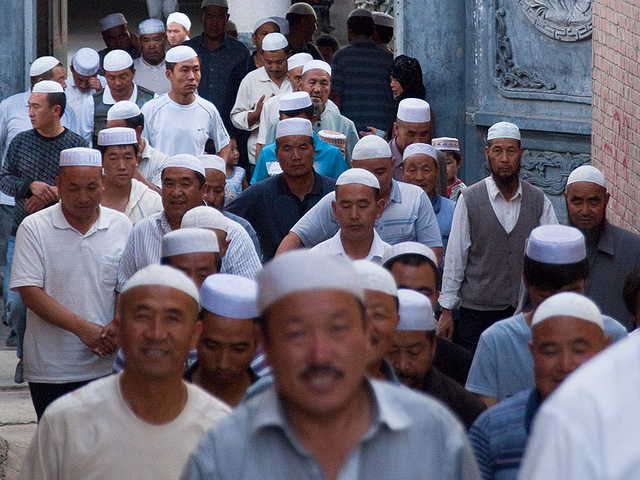
The mid-August standoff between Hui Muslims and Chinese officials seeking to demolish the new Weizhou Grand Mosque in Ningxia may not have garnered the same global attention as the mass internment of Uyghur and Kazakh minorities in Xinjiang, but this event represents not only a turning point in the relationship between Beijing and China’s sizeable Hui ethnic minority, but also a clear expansion in the scope of China’s crackdown on its Muslim minorities.
China’s Hui Muslim minority—the country’s third-largest ethnic group, which comprises more than 10 million people—has long enjoyed a better relationship with Chinese authorities than its Uyghur brethren in China’s west. Unlike the Turkic Uyghurs, Hui are close to Han Chinese in physical appearance and culture, they speak Mandarin and they do not have a history of separatism and resistance to rule from Beijing. Until recently, Hui have faced little scrutiny and few restrictions on their freedom to practice what has been called Islam with Chinese characteristics. Ethnic Hui also play a crucial role in trade between China and the Middle East due to their knowledge of Arabic and mercantilist culture.
However, at the same time that the Chinese government has been promoting its Hui minority as the ‘cultural bridge between China and the Arab and Islamic world’ in the context of President Xi Jinping’s Belt and Road Initiative, two underlying trends have emerged to the disrupt the status quo enjoyed by the Hui.
First, religious observance among the Hui is increasing, and there has also been a dramatic increase in the number of Hui women wearing the hijab—a development that has been attributed to increased communication and contact between the Hui and more conservative Muslims in other countries. There have also been indications that more conservative Salafist doctrine is gaining influence within Hui communities, which has resulted in Chinese authorities placing Salafists under surveillance and closing several Salafi religious schools.
Second, the Chinese government is becoming increasingly intolerant of religion in general, and of Islam in particular. A 2017 Freedom House report on religious freedom in China under Xi noted that while Chinese government treatment of Muslims differed significantly across ethnic and geographic lines, both Uyghurs and Hui have experienced intensified restrictions and Islamophobia since Xi became leader.
The report also identified an increase in anti-Islamic sentiment among Han Chinese; numerous anti-Muslim rumours and conspiracy theories have been circulating uncensored on Chinese social media. The anti-Islamic sentiment is being reflected in a hardened policy approach at many levels of Chinese administration. For example, following the widespread public condemnation of a video of a young female Hui student in Islamic dress reciting verses from the Koran, authorities in Gansu Province re-introduced a ban on religion in schools.
In this context, while the recent standoff over the Weizhou mosque may seem inconsequential when compared to the treatment of Uyghurs in Xinjiang, it is symbolic of deteriorating relations between elements of the Hui minority and Chinese authorities. Although the decision to demolish the mosque appears to have been made at the local administration level (ostensibly because the mosque contained too many features of Middle Eastern mosques), it reflected concerns that external extremist elements are infiltrating and influencing Chinese Muslim communities, resulting in growing Arabisation of Chinese Islam. That concern was reflected in a statement by Xi at the 19th Party Congress of the Chinese Communist Party in October 2017, who declared that the party must ‘uphold the principle that religions in China must be Chinese in orientation and provide active guidance to religions so that they can adapt themselves to socialist society’.
The deterioration in relations between the Hui and Chinese authorities has implications broader than its impact on social harmony in China. As noted by La Trobe University China specialist James Leibold, China’s increasing Islamophobia risks damaging the country’s image in the Islamic world, in the process undermining China’s investment in the Belt and Road Initiative. China’s recent targeting of its Hui minority also risks alienating a key proxy in its engagement with the Islamic world. As noted above, China has used the Hui to promote trade in the Middle East, and Chinese companies tend to rely on Hui cultural consultants and subsidiaries when sending workers to Muslim-majority countries.
To date, political and religious leaders across the Islamic world have been silent on the issue of China’s treatment of its Muslim minorities, including its mass incarceration of Uyghurs and Kazakhs in Xinjiang. Economic considerations have clearly trumped any sense of Islamic solidarity and concern for the human rights of fellow Muslims. Even the publication and circulation of anti-Muslim and blasphemous cartoons of the type that sparked widespread violent protests across Europe and the Middle East have failed to elicit responses from Muslim communities outside of China.
Nevertheless, while China may have been able to defend its oppression and mass incarceration of Uyghurs as a response to the threat of terrorism, it will find it much harder to defend a policy shift that is clearly targeting groups such as the Hui that have not traditionally been prone to separatism or terrorism. Salafist doctrine has already made inroads into Hui communities in recent years, and the Hui have probably been more exposed to external religious influences than other Muslim groups due to their role in Middle East trade.
By targeting mosque construction, religious education and practice in communities that have long enjoyed relative autonomy, the Chinese government’s crackdown on Islam may prove counterproductive, because it is likely to push more members of its Muslim minorities towards more conservative or radical versions of their faith. Ethnic Hui may also be looking at the recent experience of the Uyghurs and, in the context of Weizhou mosque standoff, wondering if they’re next. China’s harder approach to Islam will also undermine the country’s image in the Islamic world, potentially jeopardising its ambitions for the Belt and Road Initiative.

